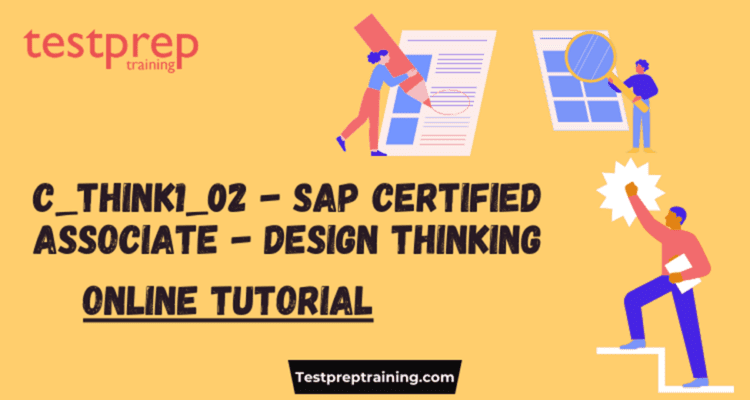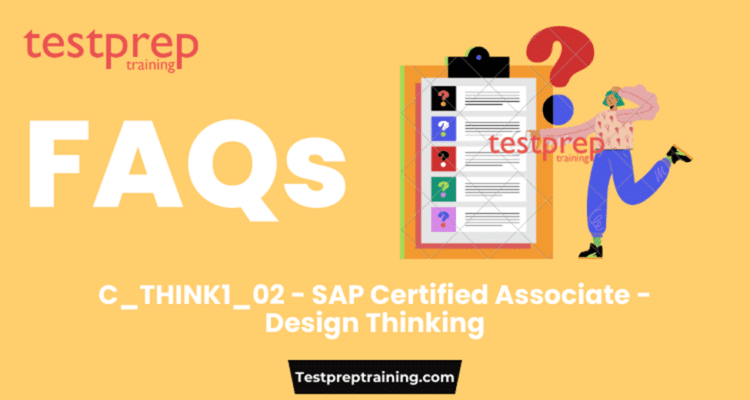C_THINK1_02 – SAP Certified Associate – Design Thinking

Earning the C_THINK1_02 – SAP Certified Associate – Design Thinking certification validates your competency in applying SAP’s Design Thinking methodology. It assesses your knowledge of the core processes, workshop organization and facilitation techniques relevant to a consultant role. The exam emphasizes your ability to leverage Design Thinking principles effectively in real-world projects. This certification builds upon the foundation established through SAP’s Design Thinking training program.
Knowledge Requirements
The C_THINK1_02 exam assesses your grasp of SAP’s Design Thinking framework, encompassing the core principles, various stages (scoping, research, synthesis, etc.), and effective workshop facilitation methods. It emphasises applying this knowledge in a consultant role, requiring you to demonstrate the ability to utilise Design Thinking to solve problems and drive successful project outcomes.
Major Tasks
The C_THINK1_02 exam focuses on your proficiency in applying SAP’s Design Thinking framework. You’ll need to demonstrate a strong grasp of the core stages – empathise, define, ideate, prototype, and test – and how to effectively guide workshops through these phases. The exam assesses your ability to translate theory into action, including user research techniques, crafting problem statements, generating creative solutions, and building prototypes for validation. This certification validates your skills in facilitating collaborative innovation and driving successful design-thinking projects.
Exam Details
- Total Questions: 80 questions
- Pass Score: 66%
- Exam Duration: 180 mins
- Exam Languages: English
SAP C_THINK1_02 Course Outline
Domain 1 – Design Thinking Methodology and Principles > (12%)
- Describe fundamental Design Thinking principles, overall methodology approach, the history of Design Thinking, and IT relevant application areas.
Domain 2 – Scoping / Understand > (12%)
- Understand the purpose of scoping within the Design Thinking methodology; describe best practices methods for scoping and understand how they work.
Domain 3 – Research / Observe > (12%)
- Understand the purpose of research within the Design Thinking methodology; describe best practices methods for research and understand how they work.
Domain 4 – Synthesis / Define Point-of-View > (12%)
- Understand the purpose of synthesis within the Design Thinking methodology, describe best practices methods for synthesis, and understand how they work.
Domain 5 – Post production & Facilitation > (12%)
- Describe and use key Design Thinking workshop facilitation rules, and describe how to deal with difficult team situations. Outline the key preparation activities for Design Thinking workshops, describe best practices for debriefing workshop results and drive results towards implementation.
Domain 6 – Ideation 8% – (12%)
- Understand the purpose of ideation within the Design Thinking methodology, describe best practices and methods for ideation, and understand how they work.
Domain 7 – Prototyping 8% – (12%)
- Understand the purpose of prototyping within the Design Thinking methodology, describe best practices methods for prototyping and understand how they work.
Domain 8 – Validation & Implementation < (8%)
- Explain the purpose of validation within the Design Thinking methodology, describe best practices methods for validation, and understand how they work.
SAP Consultant Certification Exam Retake and Reschedule Policy
- This policy applies to both testing centers and online proctored environments for SAP Consultant Certification Exams. It outlines the procedures for retaking a failed exam and rescheduling an existing appointment.
Retaking a Failed Exam
- Unsuccessful candidates have the opportunity to retake the exam. This program allows up to six attempts across different exams.
Important Points to Remember
- Once a candidate passes a specific exam version, they cannot retake it.
- Each exam version has a limit of three attempts. Failing an exam three times necessitates waiting for a new version to become available before retaking.
- Retaking any exam requires payment of a fee.
- SAP prioritizes exam security. Violations of the retake policy may lead to disciplinary action.
Rescheduling Your SAP Certified Associate Exam
The SAP Certification Hub is convenient for rescheduling your SAP Certified Associate exam. To ensure a smooth process, log in to the Hub and locate the “Exam Appointments” or “Upcoming Appointments” section. Identify the specific exam you wish to reschedule by its corresponding calendar icon. For optimal flexibility, kindly ensure any rescheduling is completed at least 24 hours before your originally scheduled exam time. Please be aware that changes made within 24 hours of your exam window may be counted as one of your allocated attempts.
Study Resources for C_THINK1_02 – SAP Certified Associate – Design Thinking
SAP Learning Hub
As the official resource for SAP certifications, the SAP Learning Hub is an invaluable starting point for your C_THINK1_02 exam preparation. It provides the most in-depth and up-to-date coverage of the exam content, ensuring you’re aligned with SAP’s specific Design Thinking framework and its application within their ecosystem. The Hub offers a variety of learning formats to cater to different learning styles. You can access comprehensive courses that break down the entire methodology step-by-step, explore interactive exercises to solidify your understanding, and even leverage practice exams to gauge your knowledge retention and identify areas needing additional focus.
Design Thinking Books by Renowned Experts
Supplement your learning with insightful Design Thinking books authored by prominent figures in the field. Explore titles like “Change by Design” by Tim Brown, a leading proponent of Design Thinking who spearheaded its integration at IDEO, a renowned design consultancy. Another valuable resource is “The Design Thinking Playbook” by Michael Michalko, packed with creative exercises and thought-provoking prompts that will help you hone your problem-solving and innovation skills – crucial aspects tested in the C_THINK1_02 exam.
Targeted Online Courses
Several online learning platforms like Testpreptraining offer specialised courses specifically designed to help you conquer the C_THINK1_02 exam. These courses can be particularly beneficial if you thrive in a structured learning environment. Look for courses developed by reputable institutions or experienced Design Thinking practitioners. They will likely provide a well-defined curriculum, expert instructors, and additional resources like downloadable materials and interactive elements to enhance your understanding.
Comprehensive Practice Exams for Focused Review
Taking practice exams from Testpreptraining is an exceptional strategy to assess knowledge retention and identify areas requiring further study. Look for practice exams that mirror the format and content of the actual C_THINK1_02 exam. Many online platforms and exam preparation resources offer practice exams, allowing you to simulate the testing experience, manage your time effectively, and pinpoint knowledge gaps that need additional focus before the real exam.
Immersive Design Thinking Workshops for Hands-on Experience
Consider attending a Design Thinking workshop to gain invaluable hands-on experience with the methodology. These workshops typically involve collaborative exercises that simulate real-world scenarios, allowing you to apply Design Thinking principles in a practical setting. This immersive experience can significantly enhance your understanding of the various stages – empathise, define, ideate, prototype, and test – and refine your problem-solving and creative thinking skills. Participating in workshops can significantly boost your confidence in applying Design Thinking concepts and navigating the C_THINK1_02 exam with a strong foundation.
SAP C_THINK1_02 FAQ

What does the C_THINK1_02 exam cover?
The C_THINK1_02 exam assesses your knowledge of SAP’s Design Thinking methodology, including the core stages (empathize, define, ideate, prototype, test) and their application within SAP projects. It also evaluates your ability to facilitate Design Thinking workshops and translate theory into practical solutions.
What is the format of the exam?
The C_THINK1_02 exam consists of 80 multiple-choice questions delivered entirely in English.
What is the passing score for the exam?
You need to achieve a score of 66% or higher to pass the C_THINK1_02 exam and earn the certification.
How long is the exam?
The C_THINK1_02 exam is allocated 180 minutes (3 hours) for completion.
What resources can I use to prepare for the exam?
The SAP Learning Hub offers the most comprehensive exam preparation materials, including courses, exercises, and practice exams. Additionally, Design Thinking books, online courses, and workshops can significantly enhance your understanding and practical skills.
Is there any prerequisite for taking the C_THINK1_02 exam?
While there are no formal prerequisites, a basic understanding of design thinking principles and experience working in a project environment would be beneficial.
How many times can I retake the exam if I fail?
There is no specific limit on the number of attempts for the C_THINK1_02 exam. However, some fees and waiting periods might apply for retakes.
What are the benefits of obtaining the C_THINK1_02 certification?
This certification validates your expertise in applying SAP’s Design Thinking framework, making you a valuable asset in innovation and problem-solving initiatives. It can enhance your career prospects within SAP and related fields.
How can I schedule my C_THINK1_02 exam?
You can schedule your exam through the SAP Certification Hub after registering and meeting any eligibility requirements.
Where can I find more information about the C_THINK1_02 exam?
The SAP Learning Hub and the SAP Certification website offer comprehensive information about the exam format, content, and registration process.
Interview Questions
Q: Briefly describe the core principles of Design Thinking and its overall approach.
A: Design Thinking revolves around human-centered problem-solving. It emphasizes empathy for users, iterative idea generation, and prototyping to create solutions that address real needs. It’s a non-linear process, encouraging exploration and refinement throughout.
Q: Can you give some examples of how Design Thinking can be applied in IT environments?
A: Absolutely! Design Thinking is valuable for developing user-friendly software interfaces, crafting innovative solutions for data management, and even streamlining internal IT processes to enhance efficiency.
Q: Why is proper scoping crucial at the beginning of a Design Thinking project?
A: Scoping helps define the project boundaries, ensuring the team focuses on a manageable problem area. This prevents scope creep and allows for a more focused and efficient design process.
Q: Describe a best practice method for user research within Design Thinking.
A: User interviews are a valuable research method. By conducting in-depth interviews, we can gain valuable insights into user needs, behaviors, and pain points, directly informing the design process.
Q: What is the role of synthesis in Design Thinking, and how does it help define the point of view?
A: Synthesis involves consolidating research findings, user observations, and data into a cohesive picture. This helps identify recurring themes and user needs, ultimately leading to the development of a clear and actionable point of view that guides the design direction.
Q: How would you handle a situation where a team member dominates the discussion during a Design Thinking workshop?
A: I would politely acknowledge their contribution and then utilize facilitation techniques, such as round-robin brainstorming, to ensure everyone has a chance to voice their ideas and participate actively.
Q: What are some best practices for facilitating a successful brainstorming session during the ideation phase?
A: Encouraging wild ideas and fostering a judgment-free environment are key. Techniques like brainwriting or mind mapping can help generate a diverse range of creative solutions.
Q: What are the benefits of creating low-fidelity prototypes in Design Thinking?
A: Low-fidelity prototypes allow for quick and inexpensive testing of core functionalities and user interactions. This enables early feedback and allows for rapid iterations before investing significant resources in high-fidelity prototypes.
Q: How does user validation through testing contribute to the success of a Design Thinking project?
A: User testing allows us to assess the effectiveness of our proposed solutions in addressing user needs. By observing user interaction with prototypes, we can identify usability issues and refine the design before implementation.
Q: What steps would you take to ensure the successful implementation of a Design Thinking project after the design phase?
A: Clear communication of the solution with stakeholders and gaining buy-in is crucial. Additionally, developing an implementation plan with defined timelines and responsibilities will help ensure a smooth transition from design to execution.

